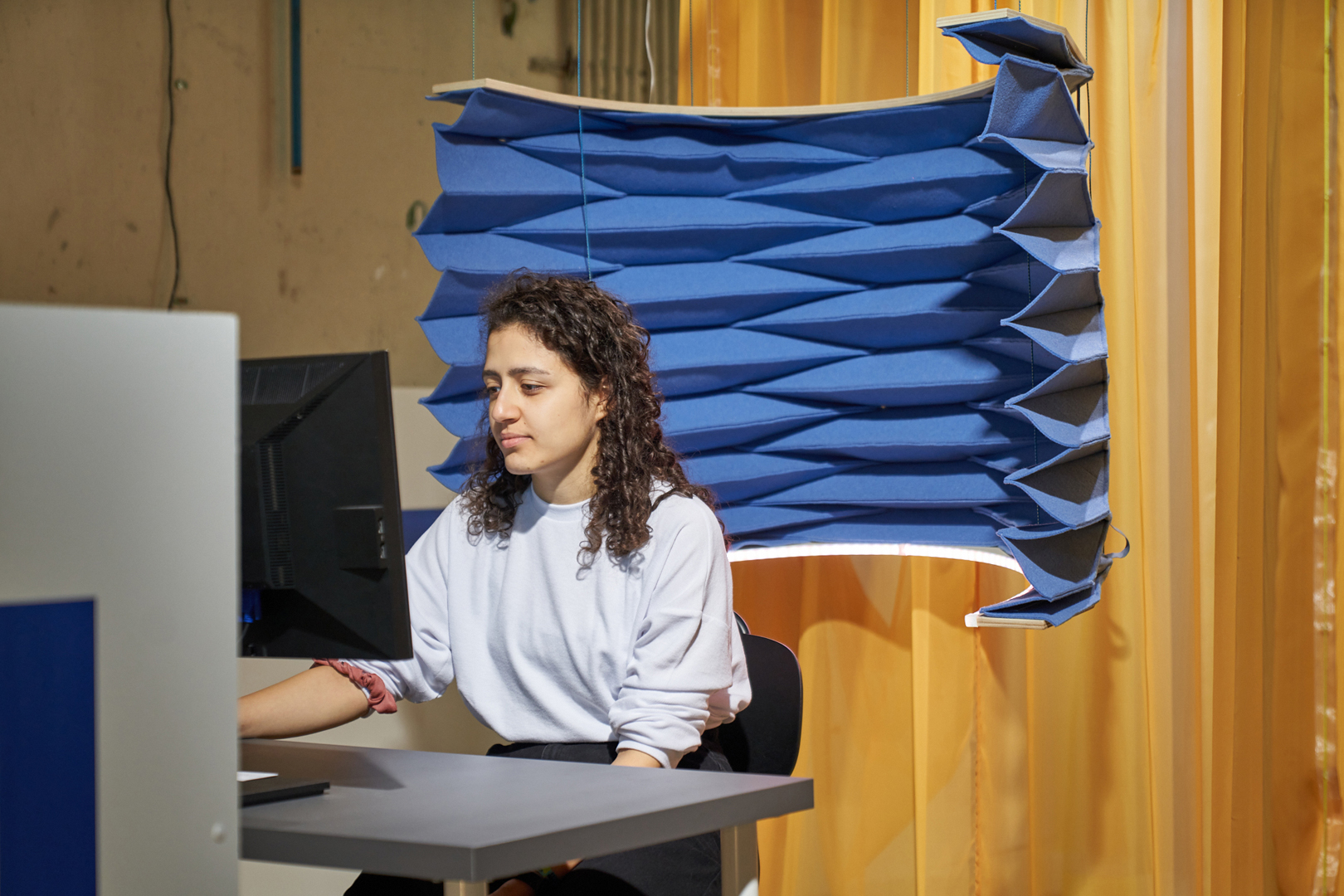“Tidal Space: Interactive Home Installation for Work-From-Home Parents”
Conference:
Experience Type(s):
Title:
- Tidal Space: Interactive Home Installation for Work-From-Home Parents
Organizer(s)/Presenter(s):
Description:
The past few years of COVID-19 lockdown have made it abundantly clear that both childcare and professional work are inextricable from the home office – as many were forced to juggle between various roles and expectations while caring for their family and working from home. Tidal Space considers the manifold needs of work-from-home parents by incorporating motorized curtains and a foldable acoustic panel into the home office. Triggered by screen activity, the curtains self-adjust to serve as spatial moderators, mediating the boundaries between different types of work. From soundproof separation for focused work, to more translucent and open configurations for checking on the children, to interactive elements allowing kids and parents to play, Tidal Space aims to
improve the home office experience for all.
References:
[1]
Daisuke Akagawa, Junichi Takatsu, Ryoji Otsu, Seiichi Hayashi, and Benjamin Vallet. 2021. Sustainable society with a touchless solution using UbiMouse under the pandemic of COVID-19. In ACM SIGGRAPH 2021 Emerging Technologies (SIGGRAPH ’21). Association for Computing Machinery, New York, NY, USA, Article 12, 1–4. https://doi.org/10.1145/3450550.3470532
Digital Library
Google Scholar
[2]
Denae Ford, Margaret-Anne Storey, Thomas Zimmermann, Christian Bird, Sonia Jaffe, Chandra Maddila, Jenna L. Butler, Brian Houck, and Nachiappan Nagappan. 2021. A Tale of Two Cities: Software Developers Working from Home during the COVID-19 Pandemic. ACM Trans. Softw. Eng. Methodol. 31, 2, Article 27 (April 2022), 37 pages. https://doi.org/10.1145/3487567
Digital Library
Google Scholar
[3]
Sabine A. E. Geurts, Toon W. Taris, Michiel AJ Kompier, Josje SE Dikkers, Madelon LM Van Hoof, and Ulla M. Kinnunen. 2005. Work-home interaction from a work psychological perspective: Development and validation of a new questionnaire, the SWING. Work & Stress 19, no. 4: 319-339. https://doi.org/10.1080/02678370500410208
Crossref
Google Scholar
[4]
Max Hudnell and Steven King. 2021. Health Greeter Kiosk: Tech-Enabled Signage to Encourage Face Mask Use and Social Distancing. In ACM SIGGRAPH 2021 Emerging Technologies (SIGGRAPH ’21). Association for Computing Machinery, New York, NY, USA, Article 10, 1–4. https://doi.org/10.1145/3450550.3465339
Digital Library
Google Scholar
[5]
Yukiko Iwasaki, Joi Oh, Takumi Handa, Ahmed A. Sereidi, Vitvasin Vimolmongkolporn, Fumihiro Kato, and Hiroyasu Iwata. 2021. Experiment Assisting System with Local Augmented Body (EASY-LAB) for Subject Experiments under the COVID-19 Pandemic. In ACM SIGGRAPH 2021 Emerging Technologies (SIGGRAPH ’21). Association for Computing Machinery, New York, NY, USA, Article 11, 1–4. https://doi.org/10.1145/3450550.3465345
Digital Library
Google Scholar
[6]
Hyunjung Kim, Martina Huynh, and Jonas Althaus. 2021. Tidal Space. (Oct 21, 2021). Retrieved August 30, 2022 from https://youtu.be/ruZN38aoqZw
Google Scholar
[7]
Leticia S. Machado, Clara Caldeira, Marcelo Gattermann Perin, and Cleidson R. B. de Souza. 2021. Gendered experiences of software engineers during the COVID-19 crisis. IEEE Softw. 38, 2 (2021), 38–44. http://doi.org/10.1109/MS.2020.3040135
Digital Library
Google Scholar
[8]
Sarah Mennicken, Jo Vermeulen, and Elaine M. Huang. 2014. From today’s augmented houses to tomorrow’s smart homes: new directions for home automation research. In Proceedings of the 2014 ACM International Joint Conference on Pervasive and Ubiquitous Computing (UbiComp ’14). Association for Computing Machinery, New York, NY, USA, 105–115. https://doi.org/10.1145/2632048.2636076
Digital Library
Google Scholar
[9]
Pat Pataranutaporn, Ali Shtarbanov, Glenn Fernandes, Jingwen Li, Parinya Punpongsanon, Joe Paradiso, and Pattie Maes. 2020. Wearable Sanitizer: Design and Implementation of an Open-source, On-body Sanitizer. In SIGGRAPH Asia 2020 Emerging Technologies (SA ’20). Association for Computing Machinery, New York, NY, USA, Article 1, 1–2. https://doi.org/10.1145/3415255.3422897
Digital Library
Google Scholar
[10]
Paul Ralph, Sebastian Baltes, Gianisa Adisaputri, Richard Torkar, Vladimir Kovalenko, Marcos Kalinowski, Nicole Novielli, Shin Yoo, Xavier Devroey, Xin Tan, Minghui Zhou, Burak Turhan, Rashina Hoda, Hideaki Hata, Gregorio Robles, Amin Milani Fard, and Rana Alkadhi. 2020. Pandemic programming: How COVID-19 affects software developers and how their organizations can help. Empirical Software Engineering. 25, 6 (2020), 4927–4961. https://doi.org/10.1007/s10664-020-09875-y
Digital Library
Google Scholar
[11]
Christine Salazar. 2001. Building boundaries and negotiating work at home. In Proceedings of the 2001 International ACM SIGGROUP Conference on Supporting Group Work (GROUP ’01). Association for Computing Machinery, New York, NY, USA, 162–170 https://doi.org/10.1145/500286.500311
Digital Library
Google Scholar





